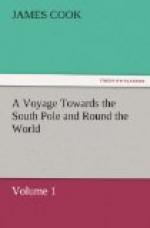Carteret.
His companion Captain Carteret kept a different route, in which he discovered the islands of Osnaburg, Gloucester, Queen Charlotte’s Isles, Carteret’s, Gower’s, and the strait between New Britain and New Ireland; and returned to England in March, 1769.
1766 Bougainville.
In November, 1766, Commodore Bougainville sailed from France in the frigate La Boudeuse, with the store-ship L’Etoile. After spending some time on the coast of Brazil, and at Falkland’s Islands, he got into the Pacific Sea by the Straits of Magalhaens, in January, 1768.
In this ocean he discovered the Four Facardines, the isle of Lanciers, and Harp Island, which I take to be the same that I afterwards named Lagoon, Thrum Cap, and Bow Island. About twenty leagues farther to the west he discovered four other islands; afterwards fell in with Maitea, Otaheite, isles of Navigators, and Forlorn Hope, which to him were new discoveries. He then passed through between the Hebrides, discovered the Shoal of Diana, and some others, the land of Cape Deliverance, several islands more to the north, passed the north of New Ireland, touched at Batavia, and arrived in France in March, 1769.
This year was rendered remarkable by the transit of the planet Venus over the sun’s disk, a phenomenon of great importance to astronomy; and which every-where engaged the attention of the learned in that science.
In the beginning of the 1768, the Royal Society presented a memorial to his majesty, setting forth the advantages to be derived from accurate observations of this transit in different parts of the world; particularly from a set of such observations made in a southern latitude, between the 140th and 130th degrees of longitude, west from the Royal Observatory at Greenwich; and that vessels, properly equipped, would be necessary to convey the observers to their destined stations; but that the society were in no condition to defray the expence of such an undertaking.
In consequence of this memorial, the Admiralty were directed by his majesty to provide proper vessels for this purpose. Accordingly, the Endeavour bark, which had been built for the coal-trade, was purchased and fitted out for the southern voyage, and I was honoured with the command of her. The Royal Society, soon after, appointed me, in conjunction with Mr Charles Green the astronomer, to make the requisite observations on the transit.
It was at first intended to perform this great, and now a principal business of our voyage, either at the Marquesas, or else at one of those islands which Tasman had called Amsterdam, Rotterdam, and Middleburg, now better known under the name of the Friendly Islands. But while the Endeavour was getting ready for the expedition, Captain Wallis returned from his voyage round the world, in the course of which he had discovered several islands in the South Sea; and, amongst others, Otaheite. This island was preferred to any of those before mentioned, on account of the conveniences it afforded; because its place had been well ascertained, and found to be extremely well suited to our purpose.




